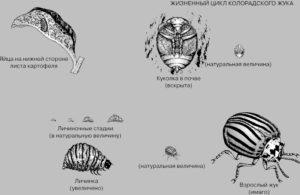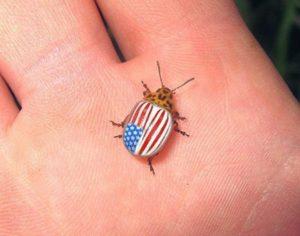What the Colorado potato beetle eats: a history of relationships with a pest
Every year, gardeners and gardeners have to protect their crops from various pests, because over the years, small rodents, insects and even birds have damaged the crops. One of the most malicious garden pranksters is the famous Colorado potato beetle and it began its harmful activity relatively recently.
Content
What does the Colorado potato beetle look like: photo
Description of the insect
Colorado potato beetle also called potato leaf beetle. This species belongs to a large family leaf beetles and is one of the most recognizable garden pests.
Name: Colorado beetle, potato leaf beetle
Latin: Leptinotarsa decemlineataClass: Insects - Insecta
Squad: Coleoptera - Coleoptera
Family: Leaf beetles - Chrysomelidae
 | Habitats: | everywhere except cold regions |
 | Dangerous for: | potatoes, tomatoes, other nightshades |
 | Means of destruction: | manual collection, biopreparations, chemicals |
Appearance
Colorado potato beetles are small in size and the length of adults rarely exceeds 8-12 mm. Body It has an oval shape, strongly convex above and flat below. elytra of the Colorado potato beetle are smooth, shiny, light yellow, decorated with longitudinal black stripes.
Well-developed membranous cells are hidden under the elytra. wings, with the help of which the beetle can fly over long distances. pronotum insect is painted orange and decorated with black spots of various shapes and sizes.
Larva
Larvae The Colorado potato beetle is slightly longer than adult beetles and their body can reach 15-16 mm. Outwardly, they look like ladybug larvae. The body is painted bright red, and on the sides there are two rows of black dots. The head and legs of the larva are also black.
Diet
Among garden plants, the main food for Colorado potato beetles is potatoes. Every year, hordes of these striped bugs destroy entire plantations of popular culture. However, the menu of this pest is not limited to potatoes, and the diet of the Colorado potato beetle may also contain:
- eggplants;
- Bulgarian pepper;
- tomatoes;
- plants of the nightshade family.
Development cycle
The development cycle of Colorado potato beetles, like that of other insects, consists of four main stages:
- egg. Eggs are laid by adult females on the underside of the leaves of host plants;
- larva. After 1-2 weeks, larvae appear from the eggs, which actively accumulate nutrients for 15-20 days and then hide in the upper soil layer for pupation;
- chrysalis. In the warm season, an adult insect emerges from the pupa in 2-3 weeks;
- imago. If pupation occurs in autumn, then the pupae enter diapause and adult beetles are born after winter.
Habitat
Currently, the Colorado potato beetle's habitat covers most of the northern hemisphere. Dangerous pests have successfully settled in the following regions:
- North America;
- Europe;
- the Baltics;
- Transcaucasia;
- Belarus and Ukraine;
- The Urals;
- Siberia;
- Far East.
History of discovery and distribution
For the first time, a dangerous pest was found in 1824 in the Rocky Mountains.
The discoverer of the species was the entomologist and naturalist Thomas Say. He caught this striped beetle eating horned nightshade leaves.
The Colorado potato beetle received its famous name only 35 years after its discovery, when it destroyed huge potato plantations in Colorado. In the second half of the 19th century, the species spread throughout North America and was first introduced to Europe. Finally settle in the Eastern Hemisphere, the Colorado potato beetle succeeded only during the First World War.
What damage does the Colorado potato beetle cause?
The Colorado potato beetle is one of the most dangerous garden pests, while both adults and larvae of all ages cause damage to plants. If striped beetles were seen on the beds, this is a signal that it is necessary to immediately start fighting insects.
These small pests have a "brutal" appetite and are able to destroy entire fields with forage plants in a short time.
Beetle control methods
Since the beginning of the 20th century, humanity has been actively fight against colorado potato beetles. A variety of methods are used to destroy a dangerous pest.
Many effective insecticides have been developed to kill the Colorado potato beetle. The most popular among them were the drugs Commander, Actellik 500 EC, Decis, Aktara and Arrivo.
This method involves manual collection of insects and is suitable for use at an early stage of infection, when the number of insects has not yet reached a critical level.
To combat the Colorado potato beetle, experienced farmers use mulching beds, spraying with infusions and decoctions, as well as planting plants that repel the pest.
This method involves the use of biopreparations based on bacteria and fungi, as well as attracting natural enemies of the Colorado potato beetle to the site.
Interesting facts about the Colorado potato beetle
Colorado potato beetles are notorious almost all over the world. In the process of observing and studying these harmful insects, people noticed several interesting features:
- they are one of the most tenacious pests and, under unfavorable conditions, can fall into diapause for 3 years;
- Colorado potato beetles fly mainly in windy weather, due to which they can reach speeds of up to 7 km per hour;
- sensing the approach of danger, cunning beetles fall to the ground with their belly up and pretend to be dead.
Conclusion
People have been fighting the Colorado potato beetle for more than a hundred years, and despite their best efforts, this striped pest comes back again and again. The only right solution to save the crop is the constant processing of the beds and the implementation of preventive measures.
Previous

